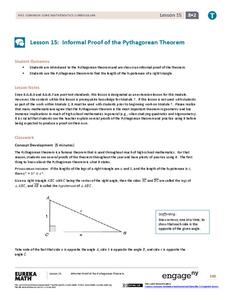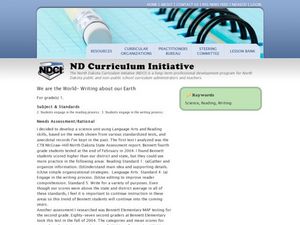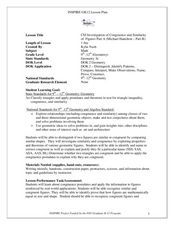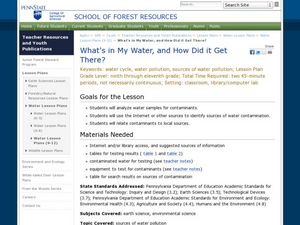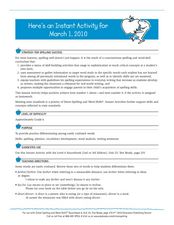Teach Engineering
Backyard Weather Station
Challenge young meteorologists to apply their knowledge of weather to build their own weather stations. The resource provides the directions to build a weather station that contains a wind vane, barometer, thermometer, and rain gauge....
Teach Engineering
Exploring the Lotus Effect
The Lotus Effect ... is it not some kind of yoga pose. In the last installment of a nine-part series, young scientists observe the Lotus Effect on lotus leaves and water-repellent cloths. They observe how motion and damage affect the...
Star Wars in the Classroom
"Shakespeare and Star Wars": Lesson Plan Day 15
To conclude the study of the play, William Shakespeare's Star Wars: Verily, A New Hope, class members craft an in-class essay comparing Doescher's adaptation to George Lucas's film, Star Wars: A New Hope.
EngageNY
Informal Proof of the Pythagorean Theorem
Prove the Pythagorean Theorem using multiple informal proofs. Scholars first develop an understanding of the origins of the Pythagorean Theorem through proofs. They round out the lesson by using the theorem to find missing side lengths...
Cornell University
Building a Compound Light Microscope
What better way to learn how to use a microscope than building your own? A lab investigation has scholars use lenses from magnifying glasses and sheets of cork to design their own compound microscopes. They calculate focal length and the...
Curated OER
Using My Money Wisely
Students discuss the costs and benefits of spending and saving their money. They identify a decision-making process to money decisions. They also examine their opportunity costs.
Curated OER
We are the World - Writing about our Earth
First graders write facts about the Earth. In this Earth instructional activity, 1st graders discuss natural resources, recycling, and how to keep the Earth clean. They work in groups to create a small book with 3-5 facts about the...
Curated OER
Minnesota-China Connections: Writing Prompts
Students write a short essay in response to a writing prompt related to a theme or issue raised within the Minnesota-China Connection Web site.
Curated OER
Spelling Success: correct spelling
Fourth graders circle the word in each row that is spelled correctly. In this spelling lesson plan, 4th graders read four words in each row and circle the correct one.
Curated OER
CSI Investigation of Congruence and Similarity
Students differentiate between similarity and congruence using polygons. In this geometry lesson, students label triangles based on their properties. They find missing sides and angles using the interior sum theorem.
Curated OER
What's in My Water, and How Did it Get There?
Students analyze water samples to see the contaminants and then use the Internet to find the sources of the contamination. In this investigative water lesson students analyze water and work together to solve the mystery of contaminants.
Curated OER
Bats
Students model how the bones in a bat wing are organized. They develop questions about bat body parts based on photographs. They hypothesize how bats locate their food.
Curated OER
Earth Science
Students explore how water and waves erode the earth. In this erosion lesson students determine the processes of wave erosion and building.
Curated OER
The Imperfect
Students practice the concept of the other past tense, the imperfect via the provided worksheet and the suggested web site.
Curated OER
Do We Have to Do This?
Learners conduct Internet research, and read articles about education to determine why particular educational practices are used, and why they are important in terms of No Child Left Behind. Students create PowerPoint presentations...
Curated OER
Some Homophones Are Verbs
Fifth graders participate in a spelling bee. In this verbs and homophones lesson, 5th graders review how most verbs are formed in the past tense and how this differs from irregular verbs. Students identify homophones and homographs and...
Curated OER
Practice Easily Confused Words
Sixth graders review vocabulary words. In this spelling activity, 6th graders review words that are easily confused. Students complete an activity at home for practice.
Curated OER
Adding s, ed, and ing To Words
Second graders learn how to add s, ed, and ing suffixes to words. In this adding suffixes lesson, 2nd graders participate in a teacher led lesson on the rules for adding endings to words before completing an associated worksheet.
Curated OER
Ohio Animal Activity
Second graders explore the various animals of Ohio. They compare the activities of the different animals during the different seasons throughout the year. Students publish their findings in a report and share it with the class.
Curated OER
Greek Mythology
Sixth graders investigate the concept of Greek Mythology and conduct research using a variety of resources. They read literature pieces and then write responses to the readings. Students also view a video in order to create the context...
Curated OER
Archaeological Study
Students analyze the difference between archaeology and anthropology while studying the evolution of different products. In this archaeology and anthropology lesson, students trace the progression of a certain tool or product and come up...
Curated OER
Geometry Jeopardy
Students identify the pattern in a problem. For this geometry lesson, students make predictions, collect and analyze data. They apply the idea of scales and measurements to the real world.
Curated OER
Forest Stewardship
Students define the term forest stewardship and they identify good forest stewardship practices. They are asked:"Does anyone enjoy spending time in the woods?" Students identify techniques of practicing good forest stewardship (taking...
Curated OER
Your Own Fresh Water Aquarium in the Classroom
Learners explore aquariums. In this fish and ecosystems lessons, students establish a freshwater aquarium environment using materials provided. Learners read about and care for the classroom fish.





